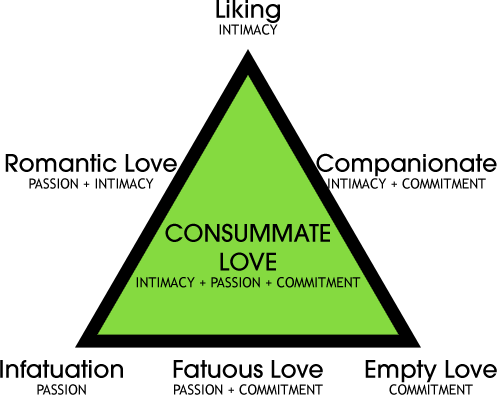This time, I am presenting the more educational, professional side of the question that I found is very effective in understanding 'love'.
Robert Sternberg's Triangle Theory of Love.
Love consists of:
- Passion: drive that lead to romance, physical attraction, sexual consummation & related phenomena
- Intimacy: feelings of closeness, connectedness & bondedness in loving relationships
- Commitment: decision that one loves someone else; commitment to maintain that love
Kind of Love
|
Passion
|
Intimacy
|
Commitment
|
Non-Love
|
-
|
-
|
-
|
Liking
|
-
|
+
|
-
|
Infatuation
|
+
|
-
|
-
|
Empty Love
|
-
|
-
|
+
|
Romantic Love
|
+
|
+
|
|
Compassionate Love
|
-
|
+
|
+
|
Fatuous Love
|
+
|
-
|
+
|
Consummate Love
|
+
|
+
|
+
|
A diagram that might be easier to understand & provide some visuals for the visual learners.
Here are just a couple of short facts:
- Phenylethylamine: chemical found in brain believed to be responsible for physical symptoms of "falling in love"; also found in chocolate
- True love: romantic love - physical attraction, shared values & goals, compatible personality
- Loving relationship fosters self-esteem
- John Lee: romantic love serves as a psychological need in humans - cravings to be loved
- Free-choice love critics: love can blind us to the faults of our future mate; we tend to fall in love with others, not necessarily for who they truly are, but for who we want them to be
Be expecting more posts from this series in the near future!
Minti~



No comments:
Post a Comment